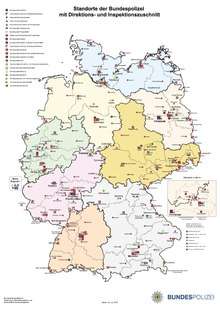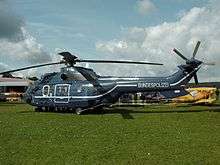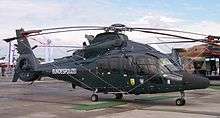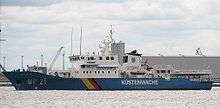Federal Police (Germany)
| Federal Police Bundespolizei | |
|---|---|
|
Logo of the BPOL (since 2009) | |
| Common name | Federal Police |
| Abbreviation | BPOL |
| Agency overview | |
| Formed | 1 July 2005 |
| Preceding agency |
|
| Employees | 42,500 |
| Annual budget | €3.288 billion (FY 2017) |
| Jurisdictional structure | |
| Federal agency | Germany |
| Operations jurisdiction | Germany |
| General nature | • Federal law enforcement |
| Headquarters | BPOL-Präsidium, Potsdam |
|
| |
| Police Officers | 30,000 |
| Civilians | 10,000 |
| BPOL-Direktions |
9
|
| Facilities | |
| Stations | 67 |
| Helicopters | 132 |
| Website | |
| www.bundespolizei.de (German) | |
The Federal Police (Bundespolizei or BPOL) is a (primarily) uniformed federal police force in Germany. It is subordinate to the Federal Ministry of the Interior (Bundesministerium des Innern (BMI)).[1] Ordinary police forces, meanwhile, are under the administration of the individual German states (Bundesländer) and are known as the Landespolizei.
The Bundespolizei was formerly known as the Bundesgrenzschutz (BGS) ("Federal Border Guard"), which had a more restricted role. Prior to 1994 BGS members also had military combatant status due to their historical foundation and border-guard role in West Germany. In July 2005 the law renaming the BGS as the BPOL was enacted.
Missions
The BPOL has the following missions:
- Border security (Grenzpolizei or Grepo), to include passport control (only at borders with non-EU member countries prior to September 2015) and the provision of coast guard services along Germany's 700 km (430 mi) of coastline.
- Protection of federal buildings such as Schloss Bellevue, the residence of the German Bundespräsident; they also protect the two highest German courts, both in Karlsruhe:
- The Federal Constitutional Court (Bundesverfassungsgericht) and
- The Federal Court of Justice (Bundesgerichtshof)
- Providing the federal government's mobile response force for internal security events.
- Providing transportation security at international airports and on German railways.
- Providing counter-terrorism forces (GSG 9).
- Providing air (or sky) marshals.
- Supporting international police missions for the United Nations and EU in Kosovo, Sudan, Liberia, Afghanistan, Gaza Strip, Moldova and Georgia.
- Providing in-house security for some German embassies.
- Providing rescue helicopter service.
The Bundespolizei can also be used to reinforce state police if requested by a state (Land) government. The BPOL maintains these reserve forces to deal with major demonstrations, disturbances or emergencies, supplementing the capabilities of the State Operational Support Units. Several highly trained detachments are available for crisis situations requiring armored cars, water cannon or other special equipment.
BPOL has investigators conduct criminal investigations only within its jurisdiction; otherwise the cases are referred to the appropriate state police force or to the federal criminal investigative agency, the Federal Criminal Police (Bundeskriminalamt, BKA).
In addition, the Bundespolizei cooperates closely with German state executive authorities, such as prosecutor's offices (Staatsanwaltschaft) in pursuing criminal investigations.
Restoration of border control tasking on all borders (2015)
On the night of 13 September 2015 Germany unilaterally reintroduced border controls, under emergency provisions of the Schengen Agreement, due to the 2015 European migrant crisis overwhelming Germany's available resources, law enforcement and otherwise. The nominally temporary border controls were initially put in place just on the border with Austria, but by the following day (Monday 14 September 2015) they were being put in place at all borders with fellow EU members. The same day, Austria and other EU members who were part of the Schengen Area began to put in place their own border controls (again meant to be temporary) in response to Germany's actions.
The new German border controls are to be primarily enforced both by the various Landespolizei of those German states that adjoin external borders, and in particular by the Bundespolizei.
Strength
The Bundespolizei consists of around 40,000 personnel:
- 30,000 are fully trained police officers.
- 21,000 provide border, railway and aviation security.
- 6,000 serve in the Alert Police.
- 3,000 serve in the following special units:
- The Central Office for Communications and Information.
- GSG 9.
- The Aviation Wing.
- 10,000 salaried civilian (unarmed) support personnel, including:
- 6,800 civil servants who perform administrative and support services.
- 2,000 Immigration inspectors (called the Individual Service) who perform operational duty handling border protection and immigration matters and airline passenger checks.
Organization


The BPOL national headquarters (BPOL-Präsidium) in Potsdam performs all central control functions. Eight regional headquarters (BPOL-Direktion) control the BPOL stations conduct rail police and border protection missions. These areas of responsibility conform to the federal state boundaries which they did not do prior to 1 March 2008.
The regional headquarters are as follows:
- Bad Bramstedt covering Schleswig-Holstein and Mecklenburg-Vorpommern.
- Hanover covering Bremen, Hamburg and Lower Saxony.
- Sankt Augustin covering North Rhine-Westphalia.
- Koblenz covering Saarland, Rhineland-Palatinate and Hesse.
- Stuttgart covering Baden-Württemberg.
- Munich covering Bavaria.
- Pirna covering Saxony, Saxony-Anhalt and Thuringia.
- Berlin covering Berlin and Brandenburg.
These regional headquarters each have an investigation department and a mobile inspection and observation unit. Moreover, they control the 67 BPOL stations (BPOL-Inspektion) which in turn control the Bundespolizeireviere or precincts located in places that require a 24-hour presence by BPOL officers.
A special Direktion is responsible for Frankfurt International Airport.
The central school for advanced and vocational training is in Lübeck and controls the six basic training schools in Swisttal, Neustrelitz, Oerlenbach, Walsrode, Eschwege and Bamberg. It is also in charge of the Federal Police Sport School in Bad Endorf and a competitive sport project in Kienbaum near Berlin. The sport school specialises in winter sport events and has trained many of Germany's top skiers and skaters such as Claudia Pechstein.
The Zentrale Direktion Bundesbereitschaftspolizei controls the mobile support and rapid reaction battalions located in Bayreuth, Deggendorf, Blumberg (near Berlin), Hünfeld, Uelzen, Duderstadt, Sankt Augustin, Bad Bergzabern, Bad Düben and Ratzeburg. The number of Bereitschaftspolizei companies increased in March 2008 from 28 to 29 comprising approx. 25 percent of Germany’s police support units.[2]
BPOL Special Units
The following special units also exist:
- The BPOL Aviation Group is directly subordinate to the BPOL HQ in Potsdam. It controls the five aviation squadrons around the country that operate the force's helicopters. These are located in Fuhlendorf (north, with satellite airfield in Gifhorn), Blumberg (east), Fuldatal (centre), Oberschleißheim (south) and Sankt Augustin (west). Its duties include; border surveillance, monitoring installations belonging to German Rail, helping in serious accidents and disasters in Germany and abroad, searching for missing persons, searching for criminals on the run, supporting the police forces of the federal states, providing transportation for persons whose security is endangered, providing transportation for guests of the Federal government, supporting federal and state authorities, and providing air search and rescue services in coordination with the 12 air rescue centers throughout Germany.
- The GSG 9 counter-terrorism group is directly subordinate to the BPOL HQ.
- The BPOL Information and Communications Center is now a department of the BPOL HQ in Potsdam.
- The water police stations with 16 patrol craft[3] and helicopters are part of the German Federal Coast Guard and assigned to coastal BPOL stations. The watercraft include six offshore patrol vessels, e.g. those of the Bad Bramstedt class, as well as a number of fast inshore vessels and one tugboat.[3]
History
In 1951 the West German government established a Federal Border Protection Force (Bundesgrenzschutz or BGS) composed of 10,000 men under the Federal Interior Ministry’s jurisdiction. The force replaced allied military organisations such as the U.S. Constabulary then patrolling West Germany’s borders. The BGS was described as a mobile, lightly armed police force for border and internal security despite fears that it would be the nucleus of a new German army. When West Germany did establish an army, the Bundeswehr, BGS personnel were given the choice of staying in the BGS or joining the army. Most decided to join the army.
In 1953, the BGS took control of the German Passport Control Service. In 1972 the Compulsory Border Guard Service was enacted by the parliament, which - in theory - is still in force, but suspended, similar to the conscription for the Bundeswehr.[4][5] In 1976, the state police grades replaced the military rank structure and BGS training was modified to closely match that of the state police forces (Landespolizei). The West German Railway Police (Bahnpolizei), formerly an independent force, and the East German Transportpolizei were restructured under the BGS in 1990.
In July 2005, the BGS was renamed the Bundespolizei or BPOL (Federal Police) to reflect its transition to a multi-faceted federal police agency. The change also involved a shift to blue uniforms and livery for vehicles and helicopters. The German Interior Ministry reviewed the structure of the BPOL in 2007 and in March 2008 made the structure leaner to get more officers out of offices and onto patrol.
Vehicles
Bundespolizei vehicles have number plates that are based on the BP XX-YYY system. BP stands for Bundespolizei. Older vehicles may still have the BGS "BG" plates.
XX is a number from 10 to 55 indicating the type of vehicle:
- 10 to 12: Motorcycle
- 15 to 19: Car
- 20 to 24: Four wheel drive car
- 25 to 29: Car
- 30 to 39: Medium four wheel drive vehicle
- 40 to 49: Trucks and buses
- 50 to 54: Armoured cars.
- 55: Trailers
YYY is a combination of up to three numbers.
The Bundespolizei have favoured, and in some cases still favor (where the model is still in production), the following types of car:
- BMW 5 Series sedans and station wagons
- Volkswagen Passat sedans and Variant station wagons
- Volkswagen Golf
- Volkswagen Transporter vans
_11.jpg)
Weaponry
This is some of the weaponry utilized by the Federal Police:
Aircraft inventory
The Federal Police now has been reduced to three flight amenities pattern of 87 helicopters. This is the largest civilian helicopter fleet in Germany.[6]



| Aircraft | Type | Versions | In service | Notes |
|---|---|---|---|---|
| Eurocopter EC-120 | training helicopter | EC 120 | 6 | replaced Allouette II in training role |
| Bell 212 | rescue- / transport helicopter | Bell 212 | 5 | to be replaced by 5 EC-155 in 2010-2012 |
| Eurocopter Super Puma | transport helicopter | AS 332 L1 | 19 | 3 more on order [7] |
| Eurocopter EC 135 | utility helicopter | EC 135 | 42 | replaced Allouette II, Bell UH-1D in liaison and MEDEVAC role |
| Eurocopter EC 155 | transport helicopter | EC 155 B | 15 | 5 further EC-155 ordered to replace remaining Bell 212 |
Former aircraft
| Aircraft | Type | Versions | In service | Notes |
|---|---|---|---|---|
| Aérospatiale Alouette II | training and utility helicopter | SA 318C | - | last Allouette left the fleet in 2007 |
| Aérospatiale Puma | transport helicopter | SA 330 | - | last Puma left the fleet in 2008, replaced by Super Pumas |
| MBB Bo 105 | rescue helicopter | Bo 105CBS | - | replaced by Eurocopter EC-135T2i |
K-9 support
Approximately 500 working dogs are used in the Federal Police at present. Most of the dogs are German shepherds. Other dog breeds are also used such as malinois, Dutch shepherd, German wirehaired pointer, giant schnauzer, and rottweiler. They accompany their handlers on daily missions in railway facilities, at airports, at the border or in physical security. Most working dogs live with the families of their handlers. Basic and advanced training is performed under the supervision of the Federal Police Academy at the Federal Police canine schools in Bleckede (Lower Saxony) and Neuendettelsau (Bavaria) where dogs and handlers go through patrol dog and explosive detection courses.
Ranks

Junior ranks (Mittlerer Dienst)
| Rank | Translation | Rank insignia | Equivalent rank in the Bundeswehr |
|---|---|---|---|
| Polizeimeisteranwärter (PMA) | Probationary Constable |  |
|
| Grenzpolizeiliche Unterstützungskraft (GUK) Bundespolizeiliche Unterstützungskraft (BUK) Polizeivollzugsangestellter (PVA) |
Border Support Officer Federal Support Officer Corrections Support Employee |
 |
|
| Polizeimeister (PM) | Constable (paygrade A7) |
 |
Feldwebel Oberfeldwebel |
| Polizeiobermeister (POM) | Senior Constable (paygrade A8) |
 |
Hauptfeldwebel |
| Polizeihauptmeister (PHM) | Chief Constable I (pay grade A9) |
 |
Stabsfeldwebel |
| Polizeihauptmeister mit Amtszulage (PHMmZ) | Chief Constable II (pay grade A9 with increment) |
 |
Oberstabsfeldwebel |
Senior ranks (Gehobener Dienst)
| Rank | Translation | Rank insignia | Equivalent rank in the Bundeswehr |
|---|---|---|---|
| Polizeikommissaranwärter (PKA) | Probationary Inspector |  |
|
| Polizeikommissar (PK) | Inspector (pay grade A9) |
 |
Leutnant |
| Polizeioberkommissar (POK) | Senior Inspector (pay grade A10) |
 |
Oberleutnant |
| Polizeihauptkommissar A 11 (PHK) | Chief Inspector I (pay grade A11) |
 |
Hauptmann |
| Polizeihauptkommissar A 12 (PHK) | Chief Inspector II (pay grade A12) |
 |
Hauptmann |
| Erster Polizeihauptkommissar (EPHK) | First Chief Inspector (pay grade A13) |
 |
Stabshauptmann |
Command ranks (Höherer Dienst)
| Rank | Translation | Rank insignia | Equivalent rank in the Bundeswehr | |
|---|---|---|---|---|
| Polizeiratanwärter (PRA) | Probationary Commissioner (pay grade A13) |
 |
||
| Polizeirat (PR) | Commissioner (pay grade A13) |
 |
Major | |
| Polizeioberrat (POR) | Senior Commissioner (pay grade A14) |
 |
Oberstleutnant | |
| Polizeidirektor (PD) | Director (pay grade A15) |
 |
Oberstleutnant | |
| Leitender Polizeidirektor (LtdPD) | Executive Director (pay grade A16) |
 |
Oberst | |
| Direktor in der Bundespolizei (als Abteilungsleiter im Bundespolizeipräsidium) | Director (Headquarters Division Chief) (pay grade B3) |
 |
Brigadegeneral | |
| Präsident der Bundespolizeiakademie | President of the Federal Police Academy (pay grade B4) |
 |
Brigadegeneral | |
| Präsident einer Bundespolizeidirektion | President (Department Chief) (pay grades B3-B6) |
 |
Generalmajor | |
| Präsident der Bundespolizeidirektion Sankt Augustin Vizepräsident beim Bundespolizeipräsidium |
President of the Police Department Sankt Augustin (pay grade B5) Vice President of the Federal Police (pay grade B6) |
 |
Generalleutnant | |
| Präsident des Bundespolizeipräsidiums | President of the Federal Police (pay grade B9) |
 |
General |
See also
- Law enforcement in Germany
- Bundeszollverwaltung - Federal Customs Services
- Landespolizei - German state police
- Volkspolizei - Former East German police
References
- ↑ OSCE Entry on BPOL http://polis.osce.org/countries/details.php?item_id=17#Country_Profile_Section_211 Archived 2009-05-24 at the Wayback Machine.
- ↑ Official BPOL news release on reorganisation (in German) Archived 2011-07-16 at the Wayback Machine.
- 1 2 "Einsatzschiffe sowie Kontroll- und Streifenboote" [Cruise and patrol vessels] (in German). Bundespolizei. Archived from the original on 24 July 2012. Retrieved 18 June 2012.
- ↑ http://dipbt.bundestag.de/doc/brd/1994/D840+94.pdf
- ↑ https://books.google.at/books?id=RcPPBgAAQBAJ&pg=PA57&lpg=PA57&dq=Grenzschutzdienstpflicht&source=bl&ots=dI2L9pnpEV&sig=evQ1ihN3bdIYICFjdNFr8fdlWgY&hl=de&sa=X&ved=2ahUKEwiBirvW4ZTdAhXqkIsKHbh3DHA4ChDoATAAegQIABAB#v=onepage&q=Grenzschutzdienstpflicht&f=false
- ↑ "Historie der Bundespolizei". Archived from the original on September 28, 2011. Retrieved 2015-04-04.
- ↑ http://strategie-technik.blogspot.de/2016/12/nh90-sea-lion-absolviert-jungfernflug.html
External links
| Wikimedia Commons has media related to German Federal Police. |
- Bundespolizei home page (in German)
- Historic Uniforms of the BGS, first camouflage, second camouflage und third camouflage pattern
- Information brochure about the Bundespolizei (in German and English) last updated August 2005
- (in German) - You can see the old Bundesgrenzschutz in historic pictures and films and you can listen songs of the Bundesgrenzschutz